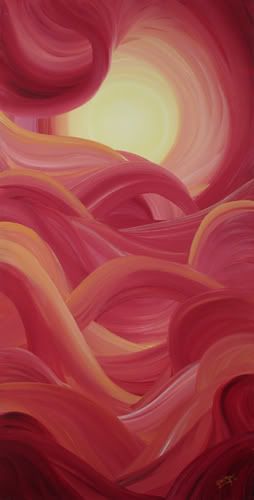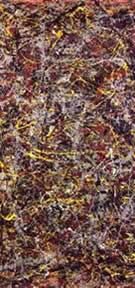Believe it or not, my oil painting technique is not something that I came up with one day. I went through dozens of canvases until I finally discovered what worked. When I did, I had what I like to call my "Jackson Pollock Revelation". Jackson Pollock was a 20th century American painter noted for his use of fluid paint and often referred to as the "Father of Abstract Expressionism". In a scene from the 2000 movie "Pollock" directed and starring Ed Harris, Pollock's paint accidently drips on the canvas and this inspires him to move in a different direction, thus changing the art world forever.
Though my art looks nothing like Pollock's, he is a major influence upon me. Like Pollock, my style is unique and developed by experimentation. I am using similar sized images to illustrate:
 |
| Ginny Gaura Alizarinscape |
Placing the works side-by-side, I see that although mine has a primary focal point, both have the energetic expression of movement. This allows the viewer's eyes to move across the painting like a free-form dance. Pollock's paintings have incredible depth when viewed in person whereas the depth of "Alizarinscape" is visible even on the computer screen. Pollock is noted for his use of black and white while I rely on intense colors. Both paintings shown have a strong linear aspect.
My process of developing a technique for my Dreamscape series came about through experimentation with linseed oil and similar mediums. I diluted my paints with the oil to make the paints thinner. Eventually I figured out that laying the oil on the canvas before I started enabled me to come up with a technique similar to wet-into-wet in watercolor, where the artist either brushes or sprays the paper with water prior to painting.
When I changed my process and the paintings began to work almost effortlessly is my Jackson Pollock Revelation. I felt that I finally discovered something that worked for me. It was a feeling of absolute elation! I could really relate to Jackson Pollock and every artist whose soul was leading them to undiscovered country. It is then when the painting seems to create itself, with no resistance involved. The artist and the painting are one, the soul of the artist is infused in the work.
When I begin a Dreamscape painting, the first color is always yellow. I do this because it is the color we associate with the source of life on Earth, the sun. Also, because it is a happy color and makes me feel good. (Like Jackson Pollock, I struggle with manic depression.) I always paint my first stroke in a spiral and then continue in overlapping strokes so that all the blending is done on the canvas.
Jackson Pollock liked to drip and splatter his paint with a stick or pour it from a can. He used synthetic enamel paints which were new at the time and I choose traditional oil paints because of their inherent messiness and the often serendipitous likelihood of adding vibrant colors to my clothes and hair. Seriously, I love the rich smell of linseed oil and the way oil paint handles. I have experimented with this technique using acrylics, but the results are slightly different.
To all owners of original Jackson Pollock paintings: I am always open to trading your Pollock painting for one of my own. As of this writing, the above featured Pollock painting, "No 5, 1948" is listed as the highest price ever sold for a painting, at 140 million dollars in 2006.
To all other art collectors and lovers of art: "Alizarinscape" is a beautiful 24"x48" oil painting and is currently listed at $1600. Quite a value compared to the price of a Pollock painting.


No comments:
Post a Comment